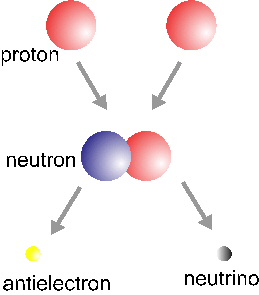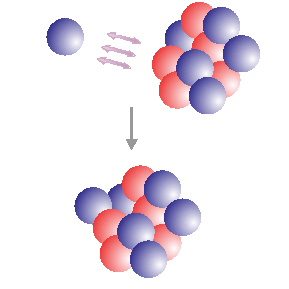Schematic view of the neutron capture process by a nucleus.
University of Oregon
The Neutron Capture Process
Neutron capture can occur when a neutron approaches a nucleus
close enough for
nuclear forces to be effective.
The neutron is captured and forms a heavier isotope of the capturing
element.
When the new isotope is unstable the neutron decays into a proton
(beta decay))
with the emission of an electron and of a neutrino.
The following movies illustrate two neutron capture processes and
subsequent element transmutation.
You might also be interested in:

A neutron is a sub-atomic (meaning it is smaller than an atom) particle. The nucleus of an atom is made up of neutrons and protons. Neutrons and protons are almost exactly the same size (a neutron has
...more
Atoms are composed of a massive, central nucleus surrounded by a swarm of fast-moving electrons. The nucleus is made up of protons and, in most cases, neutrons. Almost all of the mass (more than 99%) of
...more
The protons in the nucleus of an atom are positively charged. If protons interact, they are usually pushed apart by the electromagnetic force. (Remember, opposite charges attract, but like charges repel!).
...more
In the basic Hydrogen fusion cycle, four Hydrogen nuclei (protons) come together to make a Helium nucleus. This is the simple version of the story. There are actually electrons, neutrinos and photons involved
...more
Fusion in the core of stars is reached when the density and temperature are high enough. There are different fusion cycles that occur in different phases of the life of a star. These different cycles make
...more
Neutron capture can occur when a neutron approaches a nucleus close enough for nuclear forces to be effective. The neutron is captured and forms a heavier isotope of the capturing element. When the new
...more
A Supernova is a very massive star that explodes at the end of its life cycle. The supernova is the furnace where the heavy elements (heavier than iron) are formed.
...more
IMF stands for Interplanetary Magnetic Field. It is another name for the Sun's magnetic field. The Sun's magnetic field is huge! It goes beyond any of the planets. The Sun's magnetic field got its name
...more













